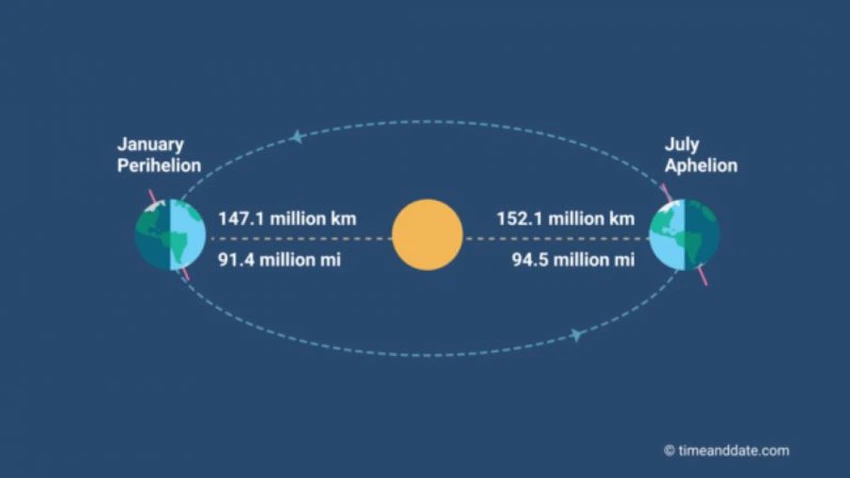Earth reaches perihelion at closest distance from the sun next Saturday
Arab Weather - Dr. Ammar Al-Sakaji, head of the Jordanian Astronomical Society, said that the Earth revolves around the sun in an elliptical orbit and is as close as possible to the sun, which is called the perihelion point, at 4:28 pm on Saturday, January 4, 2025. This phenomenon occurs once a year, and the closest distance between the centers of the Earth and the Sun at the moment of perihelion is equal to 0.9833274 astronomical units, and the astronomical unit is the average distance between the centers of the Earth and the Sun, while the farthest distance between the Earth and the Sun, which is called the solar aphelion, occurs at 7:55 pm on Thursday, July 3, 2025, and the distance is 1.0166437 astronomical units, and the difference in the distance between the aphelion and the perihelion for the year 2025 is approximately half a million kilometers.

As a result of the gravitational interaction between the Earth, the Moon and the rest of the components of the solar system, this distance varies from year to year. We can review the lowest and highest perihelion from 2001 to 2100. We find that the lowest perihelion occurred on January 5, 2020, and the distance was 0.9832436 astronomical units, and the highest perihelion will occur on January 5, 2098, and the distance was 0.9833866 astronomical units.
The solar radiation that falls on the Earth is on average about 7% more intense at perihelion than at aphelion, and the size of the Sun is about 3.6% larger at perihelion than at aphelion. This difference, of course, is so small that it cannot be detected or observed with the naked eye, and observing this increase requires advanced observational devices, so we warn against looking directly at the Sun because of its serious harm to the eye.
The annual changes in weather, between summer and winter, are caused entirely by the "tilt of the Earth's axis of rotation," not by any change in its distance from or near the Sun. Seasonal weather patterns are shaped primarily by the tilt of the Earth's axis of rotation of about 23.5 degrees, not by aphelion or perigee.
During the astronomical winter in the northern hemisphere of the Earth, the North Pole is tilted away from the Sun, the Sun is low in the sky, the days are short and the nights are long, which makes January cold. The average temperature of the entire Earth at perihelion is about 2.3 degrees Celsius lower than at aphelion, according to global average temperature data.
Another notable difference between the summers in the two hemispheres is their duration. According to Kepler's second law, planets move more slowly at aphelion than at perihelion, and as a result, Earth's northern summer is two to three days longer than its southern summer, giving the sun more time to heat the northern continents.
Because of changes in the eccentricity of the Earth's orbit, the dates on which the Earth reaches perihelion or aphelion are not generally constant, and vary from year to year. For example, in 1246, the December solstice occurred on the same day that the Earth reached perihelion. Since then, the dates of perihelion and aphelion have drifted by one day every 58 years, but in the short term the dates can vary by up to two days from year to year.
Are Earth movements related to climate change?
The Earth's movements and rotation around itself and around the sun are related to climate changes over large time scales. This can be understood in a simplified way through the "Milankovitch cycles", which indicate the importance of dynamic changes that occur in the "eccentricity", "inclination of the axis of rotation" and "circular motion around the axis of rotation" as they lead to periodic differences in the annual distribution and latitude of solar radiation on the Earth's surface, and that this orbital effect has affected the Earth's climate patterns.
The highest eccentricity of the Earth's orbit is 0.0679 , a figure that has been almost unchanged for 250 million years. The tilt of the Earth's axis of rotation relative to the orbital plane is between 22.1° and 24.5°, over a cycle of about 41,000 years. The current tilt is 23.44°, about halfway between its maximum values. Every 10,000 years, the North Pole tilts toward the Sun when the Earth is at perihelion. The Earth's orbit (an ellipse) moves in space in an irregular manner, completing a full revolution in about 112,000 years relative to the distant fixed stars. The tilt and wobble of the Earth's orbit up and down relative to its current orbit, known as precession , all of these movements have a varying effect on the Earth's climate patterns, but within large ranges of thousands of years.
See also:
The "faint" Quadrantid meteor shower peaks next Friday
The Jordanian Astronomical Society observes the crescent of Jumada al-Akhirah 1446
Arabia Weather App
Download the app to receive weather notifications and more..



